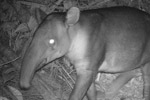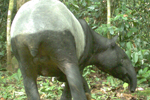Tapirs are notorious for being one of the most elusive animals in Central America. Despite their relatively large size and distinctive appearance, these stocky creatures are seldom seen by human eyes. Because of this, very little is known for certain about their behavior or the sizes of their populations.
A new study, recently published in mongabay.com’s open access journal, Tropical Conservation Science, uses a new technique to examine the behavior and distribution of Baird’s tapir (Tapirus bairdii) in the southern forests of Mexico. One of four species of Central American tapir, Baird’s tapir – currently listed as Endangered and named after the famous American naturalist Spencer Fullerton Baird – was recently ranked 34th on a list of 4,000 at-risk animals in need of urgent protection by the Zoological Society of London. According to the International Union for the Conservation of Nature (IUCN), its population has halved in the last 30 years due to illegal hunting and loss of habitat.

A Baird’s tapir. Photo courtesy of Creative Commons 3.0.
In December of 2010, a team consisting of researchers from the National Autonomous University of Mexico (UNAM) and the University of Michoacan of San Nicolas de Hidalgo, set up 25 camera trapping stations in the Biosphere Reserve of El Triunfo, a mountainous area thought to contain some of Mexico’s most diverse habitats, at a wide range of altitudes. The cameras were then checked at regular intervals for the next six months.
Researchers believed that camera-traps would be the most effective way to gauge information about behavior and population because tapirs tend to avoid humans and usually leave an area when they hear people approaching. The team decided to use a method known as the Random Encounter Model (REM) to estimate the density of population. In this case, REM involved positioning the cameras in multiple locations 500 meters (1,640 feet) apart from each other, instead of simply placing cameras at locations the animals are known to frequent, such as waterholes. Once the traps were set up and photographs started coming in, the researchers examined the frequency of those that captured tapirs. After factoring in the geography of the area and the average speed of a tapir, they found the approximate tapir density of the area to be 0.12 animals per square kilometer (0.31 per square mile). This figure suggests that Baird’s tapir remains relatively elusive. Each camera caught sight of a tapir, roughly, only once every 100 days.
 A Baird’s tapir captured via a camera trap during the study. Photo by: Carbajal-Borges et al. |
The technique of REM is still fairly new and is in the process of being developed and adjusted by zoologists and conservations around the world. However, by placing cameras at different altitudes and noting the times at which they recorded activity, the team learned that tapirs are more common at mid-altitudes and that they tend to be most active at dawn and dusk. Researchers studying tapirs in Costa Rica have made similar findings, which also suggest that increased availability of shelter and a greater variety of food might be what make mid-altitude habitats appealing to tapirs.
Camera traps have proved to be valuable tools for those trying to study and protect the world’s most secretive forest species. While REM has yet to be perfected, its potential to unveil some of the rainforest’s deepest and darkest secrets may continue to prove very useful to conservation efforts.
Citations:
- Carbajal-Borges J., et al. 2014. Density, abundance and activity patterns of the endangered Tapirus bairdii in one of its last strongholds in southern Mexico. Tropical Conservation Science Vol.7 (1): 100-114
Related articles
Tapirs, drug-trafficking, and eco-police: practicing conservation amidst chaos in Nicaragua

(10/10/2013) Nicaragua is a nation still suffering from deep poverty, a free-flowing drug trade, and festering war-wounds after decades of internecine fighting. However, like any country that has been largely defined by its conflicts, Nicaragua possesses surprises that overturn conventional wisdom. Not the least of which is that the Central American country is still home to big, stunning species, including jaguars, giant anteaters, pumas, and the nation’s heaviest animal, the Baird’s tapir (Tapirus bairdii). Still, not surprisingly given the nation’s instability, most conservationists have avoided Nicaragua. But tapir-expert Christopher Jordan, who has worked in the country for over four years, says he wouldn’t have it any other way.
Loving the tapir: pioneering conservation for South America’s biggest animal

(09/11/2011) Compared to some of South America’s megafauna stand-out species—the jaguar, the anaconda, and the harpy eagle come to mind—the tapir doesn’t get a lot of love. This is a shame. For one thing, they’re the largest terrestrial animal on the South American continent: pound-for-pound they beat both the jaguar and the llama. For another they play a very significant role in their ecosystem: they disperse seeds, modify habitats, and are periodic prey to big predators. For another, modern tapirs are some of the last survivors of a megafauna family that roamed much of the northern hemisphere, including North America, and only declined during the Pleistocene extinction. Finally, for anyone fortunate enough to have witnessed the often-shy tapir in the wild, one knows there is something mystical and ancient about these admittedly strange-looking beasts.
Malaysia may be home to more Asian tapirs than previously thought (photos)

(04/23/2013) You can’t mistake an Asian tapir for anything else: for one thing, it’s the only tapir on the continent; for another, it’s distinct black-and-white blocky markings distinguishes it from any other tapir (or large mammal) on Earth. But still little is known about the Asian tapir (Tapirus indicus), including the number surviving. However, researchers in Malaysia are working to change that: a new study for the first time estimates population density for the neglected megafauna, while another predicts where populations may still be hiding in peninsular Malaysia, including selectively-logged areas.
Photos: Scientists discover tapir bonanza in the Amazon

(01/22/2013) Over 14,000 lowland tapirs (Tapirus terrestris), also known as Brazilian tapirs, roam an Amazonian landscape across Bolivia and Peru, according to new research by scientists with the Wildlife Conservation Society (WCS). Using remote camera trapping, thousands of distribution records, and interviews, the researchers estimated the abundance of lowland tapirs in the Greater Madidi-Tambopata Landscape Conservation Program made up of three national parks in Bolivia (Madidi, Pilón Lajas and Apolobamba) and two in Peru (Tambopata and Bahuaja Sonene).
Key mammals dying off in rainforest fragments

(08/15/2012) When the Portuguese first arrived on the shores of what is now Brazil, a massive forest waited for them. Not the Amazon, but the Atlantic Forest, stretching for over 1.2 million kilometers. Here jaguars, the continent’s apex predator, stalked peccaries, while tapirs waded in rivers and giant anteaters unearthed termites mounds. Here, also, the Tupi people numbered around a million people. Now, almost all of this gone: 93 percent of the Atlantic Forest has been converted to agriculture, pasture, and cities, the bulk of it lost since the 1940s. The Tupi people are largely vanished due to slavery and disease, and, according to a new study in the open access journal PLoS ONE, so are many of the forest’s megafauna, from jaguars to giant anteaters.